Incomes rise as new skills are mastered
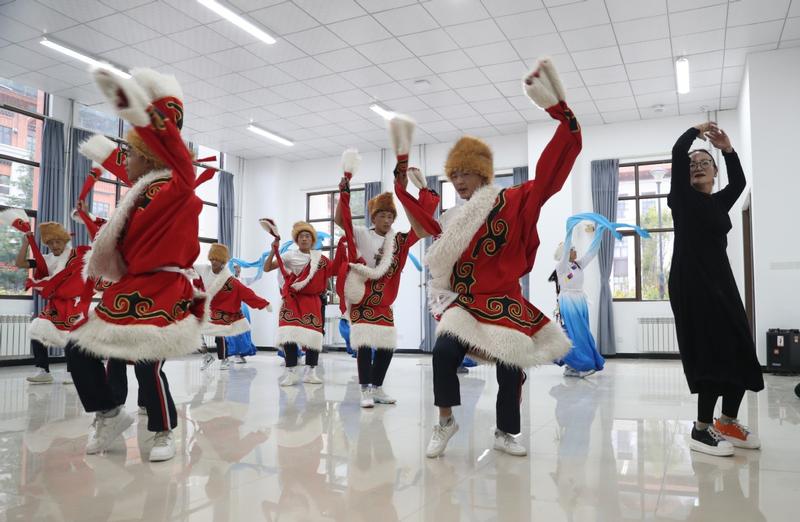 Tibetan dancing is one of the courses on offer for preschool teachers at Nyingchi Vocational and Technical School. (ZOU HONG / CHINA DAILY)
Tibetan dancing is one of the courses on offer for preschool teachers at Nyingchi Vocational and Technical School. (ZOU HONG / CHINA DAILY)
Rinmo, 18, used to live with her parents and two elder brothers in a wooden house in a remote border area of the Tibet autonomous region, where the only way to get around was on horseback.
Then, several years ago, the family was relocated to a new home in Zayu county in the city of Nyingchi, where they bought a car.
"Now, my brothers and I also have our own bedrooms," Rinmo said proudly.
While her parents and one elder brother remain at home tending to highland barley on a small plot of land, the other brother is studying at a university in Jiangsu province.
Two years ago, Rinmo applied to Nyingchi Vocational and Technical School to major in star-rated hotel management.
"I didn't perform well at middle school, and I chose the vocational school because I want to ease my family's financial burden by getting a job as soon as possible," she said.
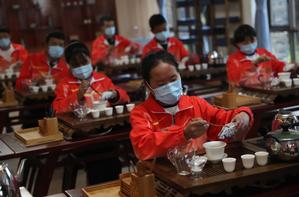 Students at Nyingchi Vocational and Technical School, Tibet autonomous region, learn to serve tea and work as chefs. (ZOU HONG / CHINA DAILY)
Students at Nyingchi Vocational and Technical School, Tibet autonomous region, learn to serve tea and work as chefs. (ZOU HONG / CHINA DAILY)
After taking a flower arrangement class, which she enjoyed, Rinmo adorned the family's new home with several jars of blooms.
"My parents were delighted when they saw the flowers," she said.
Like Rinmo, hundreds of thousands of people in Tibet used to live in rugged mountainous or remote areas with poor infrastructure and living conditions.
In recent years, to relieve poverty, the local government has relocated families to areas nearer to cities and towns that are rich in resources and have a relatively well-developed infrastructure.
Wu Yingjie, the region's Party secretary, told reporters at a briefing last month that work had been completed on 965 relocation sites and 266,000 people had moved into new homes.
Asked whether the residents had been relocated voluntarily, Wu said their wishes had been fully respected during the entire process.
"Once we finished building the houses, we invited the villagers to see the interior designs and to give their advice," he said.
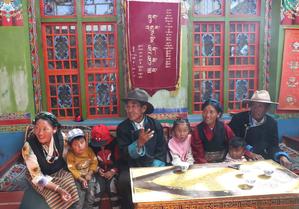 Tenzin (center), 76, who grows highland barley in a village in Shigatse city, enjoys life with his family at their new house. (ZOU HONG / CHINA DAILY)
Tenzin (center), 76, who grows highland barley in a village in Shigatse city, enjoys life with his family at their new house. (ZOU HONG / CHINA DAILY)
Wu added that many people have failed to qualify for relocation, but still want to move.
In Boma village, a relocation area in the Doilungdeqen district of Lhasa, Tse Padro chose not to take part in a project launched by the local government to transform rooms on the second floor of relocated villagers' houses into homestays for visitors.
The 56-year-old farmer, whose four children have left to work in other areas of Tibet, leaving him and his wife at their new home, said, "We are just farmers and know nothing about running a homestay."
The family moved to Boma in 2016 from a mountainous area, which can be seen from the front of the new two-story home.
Even though villagers who took part in the homestay project qualify to receive several thousand yuan in payments annually, Tse Padro still feels satisfied with his life.
Leasing 0.4 hectares of farmland he owns to an industrial park, Tse Padro and his wife earn more than 10,000 yuan (nearly US$1,500) a year. He also does occasional work in Lhasa, such as planting trees and flowers.
"Our living conditions have greatly improved and we now have full access to water and electricity supplies. Life is much more convenient than before," he said.
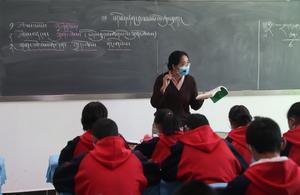 Students take a Tibetan language class at a junior high school in Lhasa. (ZOU HONG / CHINA DAILY)
Students take a Tibetan language class at a junior high school in Lhasa. (ZOU HONG / CHINA DAILY)
Free education
Rinmo, the village student relocated to Nyingchi city with her family, is among those receiving a free education thanks to a policy introduced in Tibet in 1985.
As part of the Three Guarantees policy, the local authorities initially covered all tuition, food and boarding costs for students from the region's farming families during their nine years of compulsory education.
In 2012, the policy was extended to cover kindergartens and senior high schools. It also subsidizes students from impoverished urban families.
To date, more than 20 billion yuan has been invested to assist 8.93 million students, and this year over 2.54 billion yuan has been allocated to cover the costs of 648,600 beneficiaries, according to the regional education bureau.
With more than 2,000 students, Nyingchi Vocational and Technical School, the only one of its kind in the city, runs a range of courses.
These include preparing students to become chefs at star-rated hotels, preschool teachers who excel at Chinese and Tibetan dancing, e-commerce workers and even vehicle mechanics.
Two years ago, Yangzom registered at the school to major in Chinese cuisine.
The 17-year-old comes from a village in Gyaca county, Shannan prefecture, near Lhamo Latso-also known as Oracle Lake-some 300 kilometers from Nyingchi.
Her parents drove her to the school in their car, bought with additional income earned from work such as truck driving, selling caterpillar fungus and raising yaks.
Previously, the five-member household made a living solely from growing highland barley.
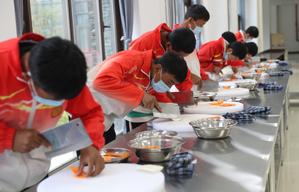 Students at Nyingchi Vocational and Technical School, Tibet autonomous region, learn to serve tea and work as chefs. (ZOU HONG / CHINA DAILY)
Students at Nyingchi Vocational and Technical School, Tibet autonomous region, learn to serve tea and work as chefs. (ZOU HONG / CHINA DAILY)
Incomes rise
As part of the region's efforts to lift people out of poverty, vocational schools also provide short-term programs for farmers and herdsmen to master skills such as running a homestay or driving a truck.
Tibet, which used to have the highest poverty rate nationwide, has spent more than any other area of the country on the challenging task of ending impoverishment for its people.
By the end of last year, 628,000 people in the region listed as impoverished had been lifted out of poverty, with their per capita net income rising to 9,328 yuan, up from 1,499 yuan in 2015.
Despite the impact of the coronavirus pandemic, in the first six months of this year, per capita income in rural areas of Tibet rose by 10.2 percent year-on-year.
Qizhala, chairman of the regional government, said rising incomes are mainly due to those who have taken other jobs, instead of relying purely on farming.
He said the short-term vocational programs are aimed at meeting strong demand to learn employment skills, adding that in some areas where grazing yaks and sheep is the major source of income, nearly half the local workforce has been left idle.
"We hope that after they learn new skills, these people are able to find work and earn money. A survey we carried out found that driving is the most sought-after skill among farmers," Qizhala said.
He added that people who used to ride horses to get around are now learning to ride motorcycles.
Other popular skills include electric welding and operating cranes and bulldozers at construction sites, where there is a shortage of such workers, he said.
Major contribution
Dawa Tsering, 26, an equipment maintenance worker at a barley processing factory in Shigatse city, has benefited from a three-month free program for new employees to master the skills they need for their work.
Earning more than 5,000 yuan a month, the third son born to an 11-member household contributed greatly to moving his family off the list of registered impoverished families in August last year.
Now, his two elder brothers are responsible for tending to highland barley on 0.67 hectares of land, along with several yaks and 50 sheep in a town in Ngamring county, Shigatse. The family earns 20,000 yuan to 30,000 yuan a year.
Dawa Tsering's younger brother, who graduated from college this year, has also found a job in Shigatse.
"There are too many people in our house, so I want to go away to try to earn a living. This is also what my parents want me to do," Dawa Tsering said.
"Hopefully, I will get promotion and become a manager in the future," he added.


